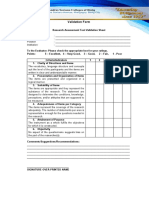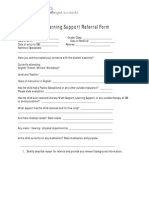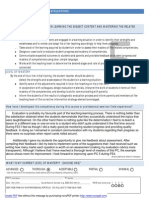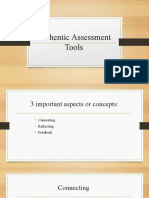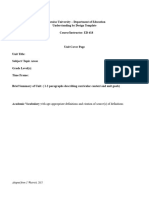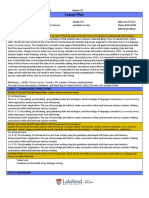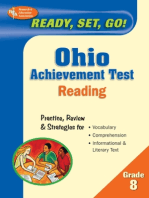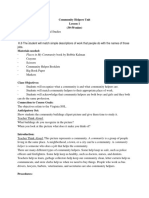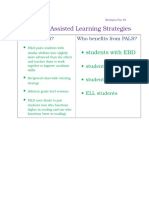Fable Lesson Plan
Fable Lesson Plan
Uploaded by
kflint91Copyright:
Available Formats
Fable Lesson Plan
Fable Lesson Plan
Uploaded by
kflint91Copyright
Available Formats
Share this document
Did you find this document useful?
Is this content inappropriate?
Copyright:
Available Formats
Fable Lesson Plan
Fable Lesson Plan
Uploaded by
kflint91Copyright:
Available Formats
DAILY LESSON PLAN
Date: 4-24-12 Lesson Title: Writing Fables (Projected/Current Unit of Study): Fables
ELA Standard(s): - Write narratives to develop real or imagined experiences or events using effective technique, descriptive details, and clear event sequences. a. Orient the reader by establishing a situation and introducing a narrator and/or characters; organize an event sequence that unfolds naturally. b. Use dialogue and description to develop experiences and events or show the responses of characters to situations. c. Use a variety of transitional words and phrases to manage the sequence of events. d. Use concrete words and phrases and sensory details to convey experiences and events precisely. e. Provide a conclusion that follows from the narrated experiences or events. Produce clear and coherent writing in which the development and organization are appropriate to task, purpose, and audience. (Grade-specific expectations for writing types are defined in standards 13 above.)
Teacher(s): Kaitlin Flint Grade: Grade 4
- With guidance and support from peers and adults, develop and strengthen writing as needed by planning, revising, and editing. (Editing for conventions should demonstrate command of Language standards 13 up to and including grade 4 on page 29.)
Learning Objectives: (Students will :) Students will know the elements of a fable. Students will fill out a graphic organizer. Students will write their own fable.
Delivery Strategies (mark with X; lesson specifics on next page):
Lecture Socratic Lesson Overhead/PowerPoint Note Group Discussion Group Activity Jigsaw Role Play Reading Analysis Audio-Video Analysis Writing Activity Debate Worksheet
__________________ __________________
__________________ __________________
Assessment and/or Evaluation Strategies (mark with X):
Observation Anecdotal Notes Work Samples Interview/Conference Checklist Oral Questioning ________________ ________________ Learning Log/Journal Self-assessment Peer-assessment Assessment Rubric Evaluation Rubric ________________ ________________ ________________ Presentation AV Presentation Written Submission Oral Report Test/Quiz ________________ ________________ ________________
Resources/Materials: White Board Marker Graphic Organizer | Lesson Delivery Specifics: Timing | Segment 1: | Have students brain storm what elements are in a fable. - A lesson is taught - Animals are the main characters - Animals have human characteristics | Segment 2: | Have students brain storm possible lessons for a fable. - Dont judge a book by its cover - Slow and steady wins the race.
Page 2
Little Friends may prove to be great friends. Dont follow the crowd. Beauty is in the eye of the beholder. Pride can be costly. Appearances can be deceiving. From the lessons the students generated I will have them choose or if they can think of one on their own they are free to use it. I will pass out the graphic organizer and have the students pick a moral to write about.
| Segment 3: | Have students create a graphic organizer to help prepare the students to write their own fable. I would walk around and help students who are struggling with the graphic organizer. | Homework/Extension/Reminders: Fables are due at the end of the week. We will be working on them throughout the week and http://www.netrover.com/~kingskid/graphic/written1.pdf
Page 3
You might also like
- Sample IepDocument10 pagesSample Iepapi-277472970100% (3)
- Fall 2018 Edtpa Lesson Plan 4Document5 pagesFall 2018 Edtpa Lesson Plan 4api-327064630No ratings yet
- PreCalculus Curriculum MapDocument7 pagesPreCalculus Curriculum MapcharityburrissNo ratings yet
- Construction of Anecdotal Comments For Report Card October 22 2012Document17 pagesConstruction of Anecdotal Comments For Report Card October 22 2012api-202232251No ratings yet
- Undergraduate Resume Guide: Goldy GopherDocument9 pagesUndergraduate Resume Guide: Goldy GopherkeenakinkinNo ratings yet
- Central Elgin Collegiate InstituteDocument5 pagesCentral Elgin Collegiate InstituteDanika BarkerNo ratings yet
- AI501 CW1 Submission TemplateDocument5 pagesAI501 CW1 Submission TemplateWasike DancanNo ratings yet
- Career Portfolio Presentation RubricDocument2 pagesCareer Portfolio Presentation Rubricapi-261468231No ratings yet
- Assessment Item 2: Units of Work and Assessment Value: Due Date: Return Date: Submission Method OptionsDocument6 pagesAssessment Item 2: Units of Work and Assessment Value: Due Date: Return Date: Submission Method Optionsapi-402868357No ratings yet
- Graduate Resume and Curriculum Vitae GuideDocument10 pagesGraduate Resume and Curriculum Vitae GuidePoorviStrNo ratings yet
- Feedback From BirkenfeldDocument2 pagesFeedback From Birkenfeldapi-273262163No ratings yet
- Faculty of Education and Languages: ST RD RDDocument7 pagesFaculty of Education and Languages: ST RD RDJefri HussinNo ratings yet
- Combined Writing Evidence TablesDocument21 pagesCombined Writing Evidence Tablesapi-115680157No ratings yet
- ATL - Skills - Termly - Target - 2023 - 2024 2Document6 pagesATL - Skills - Termly - Target - 2023 - 2024 2c i c iNo ratings yet
- TAM Final LASDocument4 pagesTAM Final LASprintsbyarishaNo ratings yet
- Assessment Strategies For Reading Writing WorkshopDocument18 pagesAssessment Strategies For Reading Writing Workshopapi-214853500No ratings yet
- Asl 1 - RubricsDocument18 pagesAsl 1 - RubricsNhalyn Torres AquinoNo ratings yet
- Writing Student Learning Objective 12-06-2010 PDFDocument2 pagesWriting Student Learning Objective 12-06-2010 PDFAbdul Razak IsninNo ratings yet
- Graduate Resume and Curriculum Vitae Guide: What Is A Resume?Document10 pagesGraduate Resume and Curriculum Vitae Guide: What Is A Resume?Teja DasariNo ratings yet
- Consolidate Writing SkillsDocument33 pagesConsolidate Writing Skillsapi-111151704No ratings yet
- Unit Twelve-Teaching Students How To WriteDocument75 pagesUnit Twelve-Teaching Students How To WriteHaerani Ester SiahaanNo ratings yet
- ASCB Validation FormDocument1 pageASCB Validation FormDaryll Louie LafuenteNo ratings yet
- Rubrics For AssessmentDocument6 pagesRubrics For AssessmentNoor Khairul Azwan100% (3)
- College of Education and Behavioral Sciences Lesson Plan FormatDocument1 pageCollege of Education and Behavioral Sciences Lesson Plan Formatapi-355576603No ratings yet
- Assessment of Writing: (Assessment in The Primary School Curriculum, Guidelines For School. NCCA, 2007, P. 4)Document17 pagesAssessment of Writing: (Assessment in The Primary School Curriculum, Guidelines For School. NCCA, 2007, P. 4)khaterine nabongNo ratings yet
- Guidelines On Writing Learning OutcomesDocument4 pagesGuidelines On Writing Learning OutcomesSuriaRAsaiNo ratings yet
- Unitplanassessment 4Document13 pagesUnitplanassessment 4api-317825538No ratings yet
- RAOUL-JULIAN-SARMIENTO-Module-in-WritingDocument7 pagesRAOUL-JULIAN-SARMIENTO-Module-in-WritingraouljuliansNo ratings yet
- REEPcurriculum_lessonplanningDocument1 pageREEPcurriculum_lessonplanningjsparr1No ratings yet
- Fs 5 Episode 8Document3 pagesFs 5 Episode 8Sharina Mae EnriquezNo ratings yet
- TextDocument3 pagesTextWanhar HabingNo ratings yet
- Cac Ela Teachers - ManualDocument88 pagesCac Ela Teachers - ManualAnn M L JacobNo ratings yet
- Resume Writing Lesson PlanDocument4 pagesResume Writing Lesson PlanChristine Joy ManlangitNo ratings yet
- Ppa FormDocument6 pagesPpa Formapi-239033587No ratings yet
- ES Referral FormDocument3 pagesES Referral FormFrancis A. BuenaventuraNo ratings yet
- Logan Matthew s267959 Etp425 A1 Dragged 10Document3 pagesLogan Matthew s267959 Etp425 A1 Dragged 10api-269291110No ratings yet
- pc5 Fe3Document1 pagepc5 Fe3api-302405741No ratings yet
- Checklist For Part 1: What I Need To Know? (Objectives)Document4 pagesChecklist For Part 1: What I Need To Know? (Objectives)Juliet Dela CernaNo ratings yet
- LearningoutcomesDocument4 pagesLearningoutcomesapi-267948590No ratings yet
- How To Create RubricsDocument5 pagesHow To Create RubricsIna KasimNo ratings yet
- Dok FlipchartDocument25 pagesDok Flipchartapi-250345202No ratings yet
- Educ8 ReviewerDocument13 pagesEduc8 ReviewervinsmokejelineNo ratings yet
- The Understanding by Design Framework: Acquisition, Meaning Making, and TransferDocument35 pagesThe Understanding by Design Framework: Acquisition, Meaning Making, and TransferDrUmeshSharma100% (1)
- Assessing Student WritingDocument29 pagesAssessing Student WritingPrecy M AgatonNo ratings yet
- Topic 3 Authentic Assessment ToolsDocument14 pagesTopic 3 Authentic Assessment ToolsHyacinth Kaye NovalNo ratings yet
- Performance Task Example and Activity TemplateDocument2 pagesPerformance Task Example and Activity Templatecarla iNo ratings yet
- Why Should Assessments, Learning Objectives, and Instructional Strategies Be Aligned?Document3 pagesWhy Should Assessments, Learning Objectives, and Instructional Strategies Be Aligned?KCD ChannelNo ratings yet
- LP Feb 8Document4 pagesLP Feb 8Ana Mae CaliaoNo ratings yet
- Assessment Job Aid RubricDocument2 pagesAssessment Job Aid RubricJana PoulsenNo ratings yet
- UbD Template - Nontable Version F15Document9 pagesUbD Template - Nontable Version F15Erin CisnerosNo ratings yet
- CLIL Action PlanDocument3 pagesCLIL Action PlanViviRojasdeMartinezNo ratings yet
- Lesson Plan: Step 1: Curriculum ConnectionsDocument6 pagesLesson Plan: Step 1: Curriculum Connectionsapi-395233182No ratings yet
- Assessment Tool TypesDocument2 pagesAssessment Tool TypesAnonymous FLo23MjyXfNo ratings yet
- Fs 5 Ep 2Document3 pagesFs 5 Ep 2api-311875892No ratings yet
- Learning OutcomesDocument2 pagesLearning Outcomesapi-300172472No ratings yet
- CUNY Assessment Test in (CATW) : Information For StudentsDocument22 pagesCUNY Assessment Test in (CATW) : Information For Studentsapi-210818684No ratings yet
- Assessment: Writing Comprehension AssessmentDocument20 pagesAssessment: Writing Comprehension AssessmentA. TENRY LAWANGEN ASPAT COLLENo ratings yet
- Course PolicyDocument13 pagesCourse PolicySherif ElMasryNo ratings yet
- Reading As Tool of Learning by Radha PDFDocument21 pagesReading As Tool of Learning by Radha PDFBhawna RountaNo ratings yet
- Social Studies Unit Plan-KindergartenDocument13 pagesSocial Studies Unit Plan-Kindergartenapi-355062161No ratings yet
- Indemnity BondDocument2 pagesIndemnity Bondpandiriramcharan046No ratings yet
- Enhanced Teacher Induction Program (TIP) Course Books - Deped TambayanDocument11 pagesEnhanced Teacher Induction Program (TIP) Course Books - Deped TambayanMARY JERICA OCUPENo ratings yet
- Vision: Goals & MissionDocument5 pagesVision: Goals & Missionசெந்தில் மணிNo ratings yet
- Area and PerimeterDocument3 pagesArea and Perimeterapi-285970439No ratings yet
- Reflections On The Education of Gifted and Talented Students in The Twentieth Century Milestones in The Development of Talent and Gifts in Young PeopleDocument11 pagesReflections On The Education of Gifted and Talented Students in The Twentieth Century Milestones in The Development of Talent and Gifts in Young Peopleapi-302240075No ratings yet
- Smoking Lesson 2 - PdhpeDocument5 pagesSmoking Lesson 2 - Pdhpeapi-316259214No ratings yet
- Chesters Way Mini RarelyDocument3 pagesChesters Way Mini Rarelyapi-242720732No ratings yet
- SSIP Annual Operationa PlanDocument20 pagesSSIP Annual Operationa PlanHasnia S. Datukan100% (4)
- English Forward Planning DocumentDocument11 pagesEnglish Forward Planning Documentapi-346324074No ratings yet
- Q3 Week 6 PE March 21Document4 pagesQ3 Week 6 PE March 21roseann.vecinalNo ratings yet
- Pals StrategyDocument3 pagesPals Strategyapi-316852381No ratings yet
- AI 63 East Asian Cinema Syllabus 2017Document7 pagesAI 63 East Asian Cinema Syllabus 2017NameoftheDoctorNo ratings yet
- Sophomore English SyllabusDocument2 pagesSophomore English Syllabusapi-236389111No ratings yet
- Senior High School Career Guidance Program and Early RegistrationDocument4 pagesSenior High School Career Guidance Program and Early RegistrationDondon Tayaban100% (1)
- HK - Curriculum - PTHDocument11 pagesHK - Curriculum - PTHMichaelNo ratings yet
- Marketing Brief Radio DisneyDocument3 pagesMarketing Brief Radio DisneyShannon ClarkeNo ratings yet
- 3 Week Review StudyPlan PDFDocument2 pages3 Week Review StudyPlan PDFDanica Alyssa EnriquezNo ratings yet
- Resume/Curriculum Vitae - Susie Mahoney, Ed.D.Document5 pagesResume/Curriculum Vitae - Susie Mahoney, Ed.D.Susie MahoneyNo ratings yet
- Lesson Plan Maori Koru ArtDocument9 pagesLesson Plan Maori Koru ArtRoisinNo ratings yet
- Kenny IepDocument5 pagesKenny Iepapi-252428564No ratings yet
- FDGFDGFDGDocument8 pagesFDGFDGFDGdfNo ratings yet
- Bengkel Program Penghasilan Bahan Intervensi BI UPSRDocument5 pagesBengkel Program Penghasilan Bahan Intervensi BI UPSRAnonymous GSybWtqyPYNo ratings yet
- Flashlight Presentation Goals and ResponsibilitiesDocument18 pagesFlashlight Presentation Goals and Responsibilitiesapi-287048888No ratings yet
- Koushik GoswamiDocument2 pagesKoushik GoswamiBasudha BanerjeeNo ratings yet
- Speech Choir: Ms. Aika Carla M. DavidDocument4 pagesSpeech Choir: Ms. Aika Carla M. DavidCarlaNo ratings yet
- Self Appraisal Report KSERT CollegeDocument70 pagesSelf Appraisal Report KSERT CollegeJavaid BeighNo ratings yet
- My Life in Grade 9Document2 pagesMy Life in Grade 9Loren YonsonNo ratings yet





















